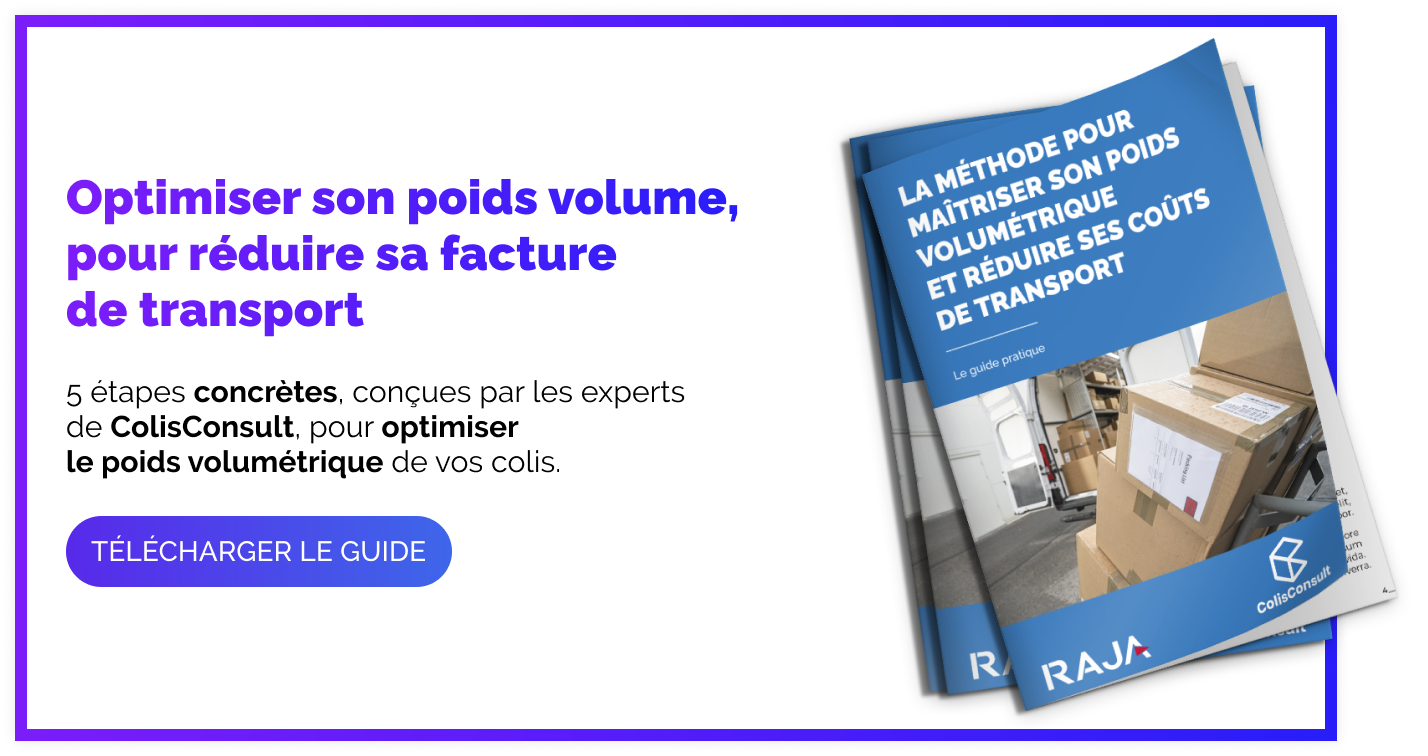Reducing transport costs is one of the priority challenges for most companies, from the smallest e-commerce business to the largest corporation. There are many methods for doing this, but sometimes a simple concept is all that is needed to move the budgetary lines. This is the case when you study the definition of volumetric weight, to better understand its impact on your transport strategy, and to really master the system of invoicing of carriers.What is volumetric weight? How to calculate it, and how to integrate it into your budgetary thinking with regard to transport? Which companies are the most impacted? These are the questions that we are going to hasten to answer
- How is the volumetric weight defined?
- What is the weight charged in the calculation?
- Which carriers use volumetric weight for their invoicing?
- Which industries are affected by volumetric weight?
- 4 steps to reduce the volumetric weight of your parcels

Comment définir le poids volumétrique ?
Commençons par une définition du poids volumétrique, tout simplement.
Le poids volumétrique est une méthode de calcul du volume d’un colis que fait un transporteur. Lorsqu’il calcule le poids volumétrique, le transporteur transforme le volume du colis en poids “fictif”, dit “volumétrique”, qui prend en compte la place prise par le colis dans un camion ou un avion.
Avec la méthode de calcul du poids volumétrique, un colis très dense sera ainsi facturé sur son poids réel. Un colis à la densité moyenne, quant à lui, très fréquent en e-commerce, sera facturé sur son volume (et donc son poids volumétrique).
On calcule généralement le poids volumétrique d’un colis en transport express par la formule suivante: (L x l x h en cm) / 5000
Admettons que vous souhaitez envoyer un colis de 50 x 30 x 30 cm en express, qui ne pèse que 3kg : son poids volumétrique est de 9 kg, et il sera donc facturé sur base.
To
What is the weight charged in the calculation?
the weight charged in the volumetric weight calculation method is the higher of the actual weight and the volumetric weight
- If your parcel contains very heavy goods, say lead, it will be charged on its actual weight
- If your parcel contains light goods, such as feathers, the weight charged will be based on the volumetric weight
.jpg) it is therefore something to think about if you want to reduce the cost of transporting your goods.
it is therefore something to think about if you want to reduce the cost of transporting your goods.
Which carriers apply volumetric weight for their invoicing?
Historically, only the air-dependent express carriers applied volumetric weight invoicing. DHL, UPS and FedEx have always applied volumetric weight, and this on all their transport services. They were the only ones to do so in the world of domestic parcel transport. However, with the rise of e-commerce, the operations of all the carriers have been very much impacted: optimisation of the filling of the containers, whatever the chosen mode of transport, is very limited. This is
why Chronopost now applies volumetric weight invoicing on the dispatch of parcels in France. Its objective: to equip agencies with costly devices for the automated measurement of the
weight
and the volume of the goods
- You use a lot of express transport: just-in-time industries such as medical, or very expensive equipment such as aeronautics are impacted by this calculation.
- You deliver parcels internationally.
en effet, ces deux modes de transport sont systématiquement facturés au poids volumétrique.
Si vous opérez en e-commerce, n’oubliez pas également qu’un élément peut faire augmenter le coût de votre transport calculé en poids volumétrique : les retours de vos clients. En effet, si vous proposez des retours gratuits à vos clients, gardez en tête que vous subissez alors les mêmes règles de calcul qu’à l’aller. Il peut parfois s’agir d’une double peine, avec des colis qui vous reviennent à moitié remplis, mais facturés au poids volumétrique.
4 étapes pour réduire le poids volumétrique de vos colis
Maintenant que le poids volumétrique n’a plus de secret pour vous, il est temps d’optimiser celui de vos colis, pour réduire significativement vos coûts de transport. C’est parti !
Étape 1 : Repenser vos délais de livraison si nécessaire
Vous le savez désormais : la facturation au poids volumétrique est systématique lorsque vous proposez à vos clients des livraisons
- Dothey want really fast deliveries? If so, keep the express delivery option – otherwise you risk a bad customer experience.
- Ifthey want valuable goods delivered against a signature, then express delivery is crucial.
- Can they wait longer for delivery? Choose a delivery method other than express, to avoid being charged by weight.
en réfléchissant finement aux besoins de vos destinataires, vous économisez déjà potentiellement une partie de votre budget transport, sans entacher l’expérience client proposée.
Étape 2 : Analyser vos envois par tranche de poids facturés
Deuxième étape pour réduire le coût de transport de vos marchandises en gérant finement votre poids volumétrique : analyser vos pratiques actuelles d’envoi de colis, pour les rationaliser au mieux.
Commencez par analyser les dimensions de vos emballages actuels, en observant le poids volumétrique qui correspond à chacun d’entre eux, et en prenant en compte la fréquence à laquelle vous envoyez chaque référence.
Puis, il s’agit de répartir vos envois par tranche de poids facturé. Idéalement, fixez-vous sur les grilles tarifaires proposées par vos transporteurs ; il s’agit en règle générale de tranches de 500g à 1kg, mais chaque transporteur a ses spécificités.
Vous pourrez ensuite analyser ce tableau,pour repérer les
tranches
de po
- Think of pouches for less fragile products. Plastic, padded for more protection, kraft paper or cardboard for more eco-responsible packaging… the choice is vast! Pouches are very light, and allow you to pack your products as closely as possible, to reduce the weight volume of your parcels.
- Consider large capacity pouches for bulkier products. The pouch is also available for larger products, such as shoe boxes. Large capacity opaque plastic pouches, “return” plastic pouches, cardboard box pouches… it’s up to you to find the one that suits your products!
- Choose extra-flat cases or boxes for flat products. More protective than pouches, they can allow you to send your products with less weight and volume, while enhancing your brand image through packaging.
- Choose variable height crates for your large orders– this is a crate with easy-to-cut grooves that allow you to fit your crate as close as possible to the goods it contains.
- Avoid “custom” packaging and use “standard” sizes instead – this is a basic tip, but one that will help you to rationalise your budget.
take the time to consult the RAJA cardboard box search engine to find the references that will allow you to pack your products as closely as possible, to reduce the empty space in your parcels, and therefore your transport bills.jpg)
step 4: Reorganise the warehouse processes
Well done: you have optimised the weight volume of your parcels! However, for a truly complete optimisation, don’t stop there and rethink all the processes in your warehouse accordingly. Indeed, following this optimisation, your operators have a deeper range of packaging at their disposal. As a result, the order preparation phase, from picking to packaging, including stock management, is made more complex. To ensure that everything runs smoothly, think about..
- Optimise your operators’ workstations: they will need more space to store all the packaging references within reach.
- Train your teams on volume weight. The success of this optimisation depends on the correct implementation of the decisions taken: this is why your operators must be made aware of the impact of volume weight on the company’s performance, and on the environment. Take the time to present them with concrete, striking figures, which will give them the motivation they need to review their usual processes
you now have all the tools you need to reduce the weight of your parcels! Now it’s up to you to apply these steps, and in particular the ColisConsult method, to quickly see an impact on your transport budgets, and to move your logistics towards more eco-responsible practices















